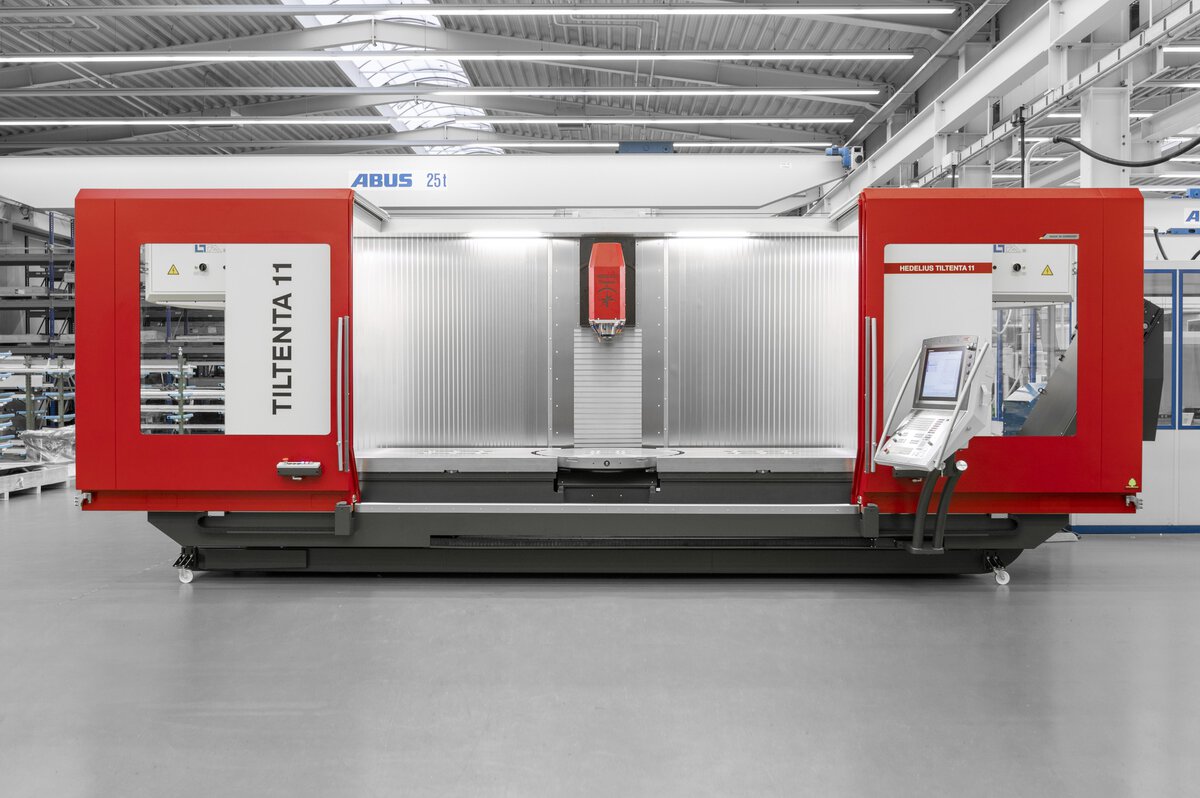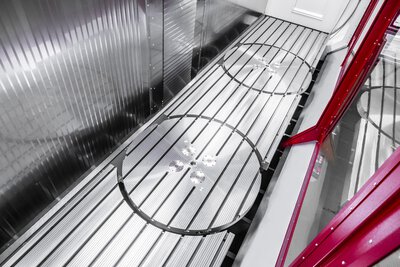18 November 2020
HEDELIUS SHOCKS INTO NEW DIMENSIONS.
TILTENTA 11 is about to enter the market.
The TILTENTA series, which can be used flexibly and is very popular with customers, has a new addition - and it's not exactly small. With a considerable Y travel path of 1,100 mm, the new TILTENTA 11 impresses with a very large work area in which even solid components can be machined with 4/5 axes. The swivelling head milling machine is available on the market in three variants, namely as the T11-2600 with an X travel path of 2,600 mm in accordance with this, as well as the T11-3600 with an even larger X travel path of 3,600 mm and the T11-4600 with an X travel path of 4,600 mm.
With integrated NC rotary table, 5-side complete processing possible
The versatile 4-axis machining centre with infinitely variable swivelling main spindle can be upgraded to a 5-axis machining centre through the optional use of a heavy-duty rotary table integrated at the same level, making it even more flexible in production. With a maximum table load of 6,000 kg on the fixed machine table and 1,800 kg on the rotary table, the production of massive large workpieces is no problem. The contact surface of the machine table is 3080 x 1100 mm for the TILTENTA 11-2600, 4080 x 1100 mm for the TILTENTA 11-3600 and 5080 x 1100 mm for the TILTENTA 11-4600.


Large travel paths, large tool magazine
Not only the work area, but above all the travel paths are impressive: At 2600 x 1100 x 900 mm (x/y/z), the TILTENTA 11-2600 is ideally suited for large welded constructions or base plates, but smaller components can also be clamped several at a time. The TILTENTA 11-3600 and 11-4600 provide significantly more work area in the X-axis. The machining centres have 65 tool positions as standard and can also be equipped with an additional 180 tools to open a total of 245 tools using a standby magazine.
50 kW spindle for heavy-duty machining
The milling machine from the HEDELIUS swivelling head family offers a wide range of spindle options. You can choose between SK 40 and HSK A63 tool fittings and spindle speeds of 14,000, 15,000 and 18,000 rpm. In terms of spindle output, you can choose between 22, 29, 35 and 50 kW, which means that the TILTENTA 11 is also well installed for heavy-duty machining.


Very high flexibility
With the combination of a large contact surface and high clamping weights, large travel paths and a generous work area, a precise swivelling spindle and a built-in rotary table as well as the large tool magazine, the TILTENTA 11 enables enormous flexibility in production. The swivelling head machining centre helps to ensure that customer orders can be processed faster and more precisely and that tooling times and costs are significantly reduced.
The TILTENTA 11 series.
More news.

We will be on company holidays from 23 December 2024 to 03 January 2025.
Our service will still be available for you on 23 December 2024 and will not be available for you again until 02 January 2025.
Our sales team will be available for you again from 06 January 2025.

In manufacturing companies that mainly produce small batch sizes, every minute of spindle time counts - or so the theory goes. In practice, however, the proportion of productive spindle time compared to working time is often less than 40 per cent. The search for tools, clamping devices and information, as well as set-up, tie up valuable resources and leave many operating companies far behind their potential. There are many ways to sustainably close flexibility - and thus performance - in production. But every manufacturing company is different. The trick is therefore to find your very own recipe for success.

Advancing automation has long since arrived in mechanical engineering and contract manufacturing - but many companies still face challenges, especially when it comes to small batch sizes. While large-scale production is already largely automated today, flexibility in smaller quantities, which are often the order of the day in contract manufacturing, poses a particular challenge. How can automation be made to pay off here too without presenting machine operators with insurmountable hurdles?















































































































































